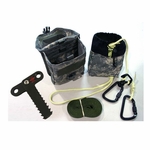|
|
| Mission Critical Equipment Serving Public Safety Professionals & Agencies |
Fax 315-626-6606 |
Escape / Bailout RIT Kits

Personal Escape Ropes, Search Ropes, Escape Descenders, and Escape and Drop bags. Ropes featured include Aramid, Aramid/polyester Hybrid, and polyester ropes for escape, search, and rapid intervention. Includes products by RescueTECH, ISC, Omega Pacific. Great for High Angle Rescue, Confined Space Rescue, Water Rescue, Search and Rescue, rope rescue. Alternate Force carries a wide variety of equipment and gear supporting the success of your mission. Please Contact Us for assistance, quotations or with any questions about your mission needs.
- Badges & Insignia
- Bags, Packs & Pouches
- Ballistic Armor
- Communications
- Defense & Control
- Drug & Alcohol Control
- Duty Gear
- Entry / Tools / Knives
- Fingerprinting
- Fire Fighting
- Fitness & Gym Gear
- Flashlights & Lighting
- Forensic / Investigation
- Gloves
- Helmets
- Handcuffs / Restraints
- Medical Reponders
- Optics & Imaging
- Outdoor Ops Gear
- Personal Protection
- Riot Control Gear TEU
- Search & Rescue
- Surveillance & Detection
- Training Equipment
- Uniforms & Accessories
- Water Rescue & Safety
- Shipping Information
- Clearance Section
- Premium Brands
Badges & Insignias
| Custom Badges for ProfessionalsCollar LettersFamily BadgeMedals | Money Clips / Buckles / Key FobsName PlatesInsignia CollectionTie Bars & TacksUniform BarsWallets / Badge AccessoriesAcrylic Enclosed |
Storage Bags, Backpacks, Cases, Holders, Pouches and Organizers
Ballistic Armor - Shields, Helmets & More
| Ballistic Body ShieldsBody ArmorBallistic Helmets | Ballistic PlatesPatrol / Responder Ballistic KitsBomb Protection & EOD EquipmentPlate Carriers |
Communications
Professional Use Batons / Chemical Agent & Defense Tools
Substance Field Testing, Screening & Education
| Drug and Narcotic Test KitsNarcotic Evidence Bags | Body Fluid Collection KitsForensics and Narcotics TrainingScales |
Duty Gear & More
Entry / Tools / Knives
Fingerprinting
Fire Fighting
Fitness & Gym Gear
Flashlight , Lighting & Illumination Tools
Crime Scene Forensic Investigation
Gloves
Helmets
| Ballistic HelmetsMounted Patrol / Parade HelmetsRiot HelmetsHelmets for Search & Rescue | Water Rescue HelmetsWork Sport & Climbing HelmetsTransport Hoods / Helmets |
Handcuffs / Restraints
Medical Reponders
Optics & Imaging
Outdoor Gear and Survival Equipment
Personal Protection
Disturbance / Riot & Crowd Control
Search & Rescue
Surveillance Detection and Inspection Equipment
| Inspection MirrorsMetal Detectors Walk-Through Detection
Handheld Metal Detector & Security Wands
Ground and Underwater Metal Detectors
BinocularsThermal Imagers | Night Vision Gear |
Training Equipment for the Professional
Uniforms & Accessories
Water Rescue and Safety Equipment
Clearance Items on the Move
| BlueGun Clearance Products |
Premium Brands
home | Policies | About Us | Contact Us | Site Map | View Cart | Legal | Security | Government SalesCopyright 2026 Alternate Force. All rights reserved.




























